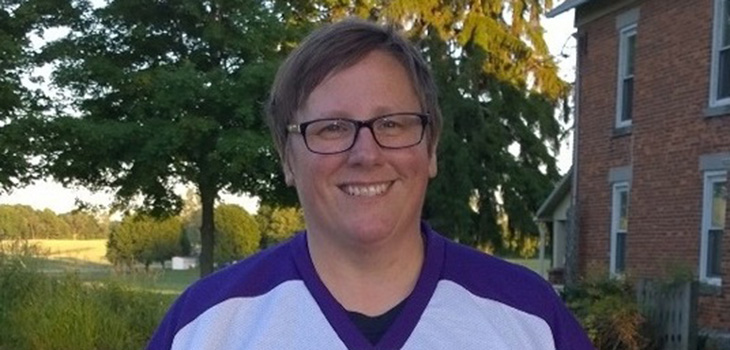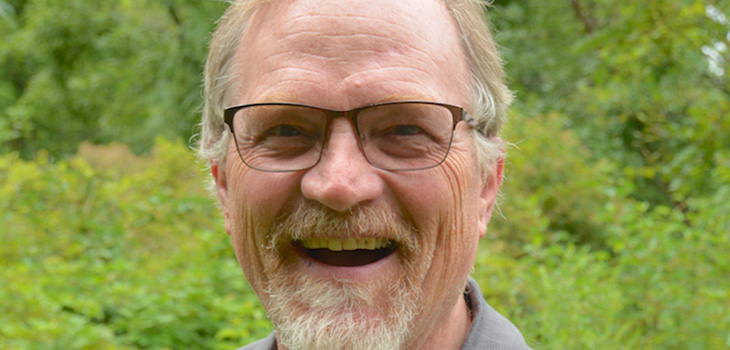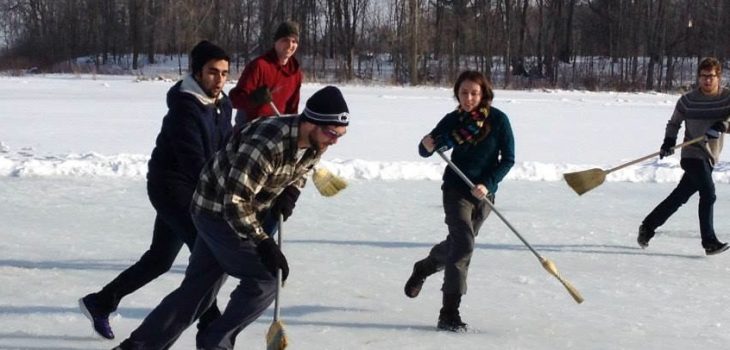 Four days a week at noon, a small caravan leaves from the Farmstead Barn. There are two wagons, three teachers and a gaggle of 14 preschoolers wearing matching backpacks and rubber boots. The children take turns pulling the wagons which carry supplies for the day.
Four days a week at noon, a small caravan leaves from the Farmstead Barn. There are two wagons, three teachers and a gaggle of 14 preschoolers wearing matching backpacks and rubber boots. The children take turns pulling the wagons which carry supplies for the day.
Out for an excursion
“Do you know what an excursion is? We get to go somewhere we don’t normally go!” a child told me proudly as we walked, suggesting that I am lucky to have shown up on a Wednesday. The Wednesday ritual allows for trips into the prairie, to the Merry Lea Sustainable Farm or other interesting places within walking distance. I was glad for the tip. It was in the 40s and rainy, so I might have thought myself unlucky if I hadn’t had four-year-old help.
“You found an interesting bumpy-looking thing. Do you want to take that along to the classroom?” Carol Good-Elliott asks one of the boys who has picked up a milkweed pod. The pod comes along to the classroom, where it could be an interesting focus for sit spot time.
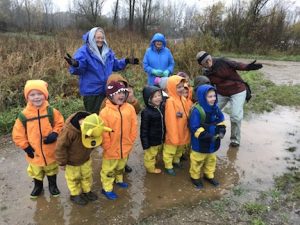 Their destination is a clearing in the woods near where the Kesling Wetland and Kesling Prairie intersect. There, they hang their backpacks under an open shelter and find their “sit spots.” Like many other age groups at Merry Lea, from kindergarten to graduate level, the preschoolers spend time watching and listening with a journal in hand. The vibrato of a singing bowl marks the beginning and end of the quiet time.
Their destination is a clearing in the woods near where the Kesling Wetland and Kesling Prairie intersect. There, they hang their backpacks under an open shelter and find their “sit spots.” Like many other age groups at Merry Lea, from kindergarten to graduate level, the preschoolers spend time watching and listening with a journal in hand. The vibrato of a singing bowl marks the beginning and end of the quiet time.
How do animals stay dry?
“How was today different from yesterday?” Carol asked the circle of children, now perched on tree rounds.
“Things look more brown.”
“I heard a crow squawk.”
“It’s easier to see the water because there are fewer leaves.”
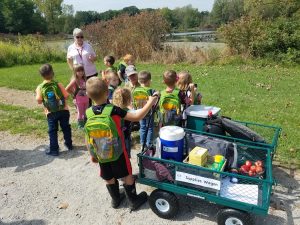 “I wonder how birds stay dry on a day like today. And what about caterpillars?” Carol muses as she introduces the day’s excursion. As they head out to the prairie, she gives each child a plastic animal and the challenge to find it a place to hide from the weather.
“I wonder how birds stay dry on a day like today. And what about caterpillars?” Carol muses as she introduces the day’s excursion. As they head out to the prairie, she gives each child a plastic animal and the challenge to find it a place to hide from the weather.
“I got a snake!…I got a lizard!…I got a frog!”
Soon the snakes, lizards and frogs are hiding under leaves and behind tree bark. Since everyone has boots, there are also puddles to splash in.
As I watched the pint-sized explorers, I thought back to a workshop I’d attended entitled, “Lessons from the Forest: How Great Preschools Place Nature at the Heart of the Curriculum.”
Nature preschools rising
“Something changed in 2012,” Christy Merrick of Natural Start Alliance told us as she shared a graph shaped like a hockey stick. That year and following, the number of nature preschools in locations around the world jumped dramatically. Perhaps in response to the statistics about screen time and phone addiction, parents are seeking outdoor experiences for their children. In the U.S., 80% of nature preschools have a waiting list.
Inclusion of all children was very important to the workshop instructor. She stressed that all children can benefit from learning outdoors, including those with developmental needs and those in diapers. She was concerned that special education children, racial minorities and bi-lingual children have less access to these services.
Workshop participants came from a wide array of contexts. A professor from Australia described how nature preschools in her country are based in national parks and teach families to enjoy nature and care for the parks together. A nature preschool administrator from Alabama described how her nature preschool partnered with Head Start in order to give children access to multiple kinds of support.
Another attendee administered a school at a zoo that served as a bridge between low-income and affluent families.
I left Merry Lea’s nature preschool, damp but grateful. I was glad I didn’t have to do the laundry for this group, but I still wished every child in the country could have outdoor education like this.

